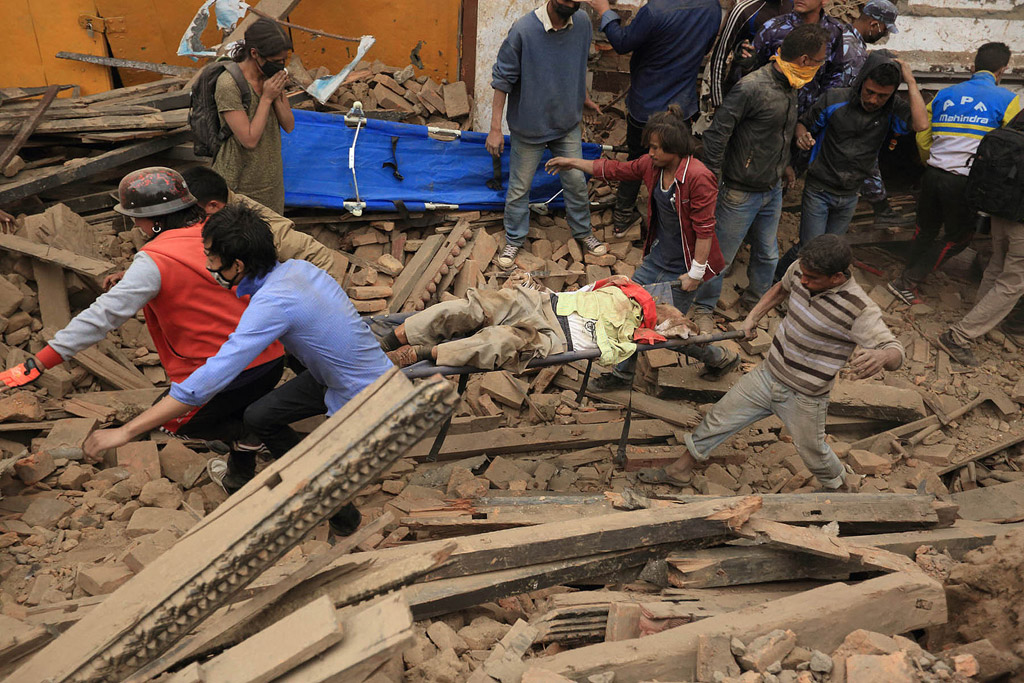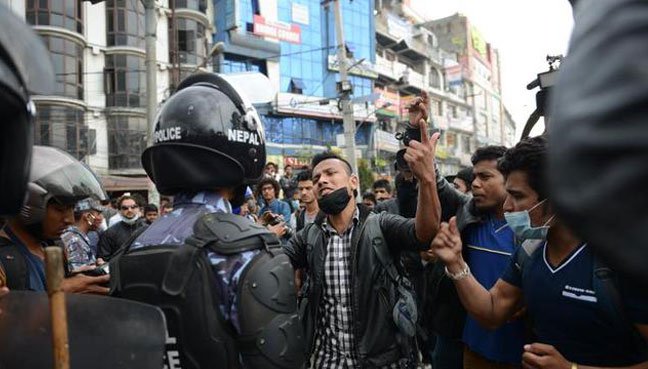Earthquake in Nepal: A Country Already Shaken by Impoverishment
by Li Onesto | May 4, 2015 | Revolution Newspaper | revcom.us
It has now been over a week since a powerful earthquake hit Nepal on April 25. At 11:56 am the ground violently shook and shifted, and within minutes in the capital of Kathmandu, a densely populated city of 1.2 million people, buildings were reduced to rubble. In the rural areas, where most of the people live, whole villages were flattened. An estimated eight million people were affected by the quake in 39 of Nepal’s 75 districts.

Fighting to save survivors of the Nepal Earthquake, April 29. Photo: UN
As of May 3 news sources in Nepal were reporting the death toll at over 7,000 people and the number of injured at over 14,000—numbers that will continue to climb as rescue teams reach more villages in remote areas. (ekantipur.com)
Roads in much of Nepal’s countryside are bad to begin with, some only accessible by foot. Now even some of these are blocked by landslides, making it impossible to get to some villages. Relief supplies can only be gotten to many areas by airlift.
Beginning news reports beamed around the world were mainly from Kathmandu—showing desperate rescue efforts in buildings that had become tombs for many bodies, with very few survivors trapped underneath the rubble. Tens of thousands were sleeping in the streets, terrified of staying in remaining buildings because of continuing aftershocks. Then in the week after the earthquake, reports from areas outside Kathmandu made clear the horrifying dimensions of the destruction in the country as a whole.
More than 80 percent of Nepal’s over 29 million people live in the countryside and, according to the United Nations, as many as 600,000 houses have been destroyed in 13 districts. Some 4.2 million people are now in urgent need of water, sanitation, and hygiene support, and 3.5 million people need food assistance.
The Red Cross reported that in Sindhupalchok, northeast of Kathmandu, 1,400 people have died and that about 40,000 homes, about 90 percent of the houses, were destroyed. The hospital had collapsed and 3,000 people were still unaccounted for. (countercurrents.org)
Vim Tamang, a resident of Manglung near the epicenter, said, “Our village has been almost wiped out. Most of our houses are either buried by landslide or damaged by shaking.” Tamang said that half the village’s population was missing or dead and that “all the villagers have gathered in the open area. We don’t know what to do.” (Guardian, April 25, 2015) In Saurpani, only five hours by car from Kathmandu, there were reports that almost all of the 1,300 houses had collapsed, that people had no food or water, and that survivors had to sleep in the open with bodies still scattered about. (New York Times, April 27, 2015)
The epicenter of the earthquake was about 50 miles west of Kathmandu, in the Gorkha district. Rebecca McAteer, a doctor from the U.S. who went to this district, said that 90 percent of the houses were “just flattened,” and that in addition to losing their houses people also lost their livestock and food. (newsday.com) Pokhara, one of Nepal’s major cities with a population of about 250,000 people, about 50 miles farther west of the epicenter, was also hard hit. In a nearby area, in a village of about 2,000 people, it was reported that almost every one of the 1,100 homes was decimated. (BBC.com, April 27, 2015)
The situation for the survivors of the quake has become increasingly dangerous. There is lack of safe drinking water and the threat of disease and epidemic, including cholera.
In many districts, the people had just recently harvested winter grains, which got buried by the earthquake. Now the farmers will have to wait until December to harvest the rainy season’s crops, but meanwhile there will be no food for people to eat. Seed stock was destroyed for the mid-May sowing season, so farmers may not even be able to plant another crop; and if they miss this month’s planting season they won’t be able to harvest rice, Nepal’s staple food, until late 2016. There is a real threat of famine and starvation in this already very poor and malnourished country.
Volatile Social Situation

Survivors of the Nepal earthquake clash with riot police in Nepal's capitol city, Kathmandu.
People are desperate and they are also mad, saying the government has been slow to respond. On Wednesday, April 26, there were people clashing with riot police in Kathmandu. There were reports that about 200 people blocked traffic in Kathmandu to protest the slow pace of aid delivery. (usnews.com) There was also a confrontation between the police and hundreds of people who were waiting in lines, trying to get buses leaving Kathmandu. (Guardian.com) After the government announced that it would provide free buses to the rural areas, thousands of people began gathering from before dawn outside the main bus station. Some wanted to check on the fate of family and loved ones in the countryside; others wanted to get out of Kathmandu, fearful of more aftershocks in the city. But when the buses failed to show up, people got mad and there were some clashes with the police. The media also reported that in Kathmandu, the Prime Minister, Sushil Koirala, was confronted by survivors desperate for relief deliveries when he visited a hospital. (Guardian.com, April 29, 2015)
There have also been reports of acts of protests in other areas. In the district of Dolakha, there was a report that people smashed windows and broke into government offices to demand relief supplies. (channelnewsasia.com) In the village of Sangachowk, angry villagers blocked the main road with tires and stopped trucks of rice and other aid headed for other areas. The villagers also reportedly blocked a convoy of army trucks loaded with relief supplies, leading to a tense standoff with armed soldiers. (BBC.com, April 30, 2015)
The Disaster of Domination and Impoverishment
Nepal is ranked 11th in terms of countries at risk of vulnerability to earthquakes. And out of 21 cities around the world that are in similar earthquake/hazardous zones, Kathmandu is rated the worst in terms of the impact an earthquake would have on the people who live there.
Speaking to the relationship between these two things, seismologist James Jackson, head of the Earth Sciences Department at the University of Cambridge in England, made a very important point: While the trigger of the disaster is natural—an earthquake—“the consequences are very much man-made.”
Internationalism—The Whole World Comes First!
From BAsics, from the talks and writings of Bob Avakian, a book that draws from more than 30 years of work by Bob Avakian, Chairman of the Revolutionary Communist Party, USA.BAsics addresses a wide range of questions on revolution and human emancipation and is a handbook for a new wave of revolutionaries.
Nepal is one of the poorest countries in the world, and has long been oppressed—subordinate to, dependent on, and dominated by India and imperialist countries like the U.S. The vast majority of people in Nepal are peasants in the countryside, desperately poor, malnourished, and exploited by corrupt officials, landlords, and moneylenders. Nepal has a caste system—a rigidly structured social order in which different social groupings are ranked, and lower castes and oppressed ethnic groups face systematic discrimination. In the world imperialist system, Nepal also functions in part as a source of cheap migrant labor, especially in India and countries in the Middle East.
In the rural areas, where most people live, there is little or no access to health care, education, safe drinking water, sanitation, or other basic services. Women are intensely suppressed and treated as inferior in every facet of society. The difficulties of survival force many men to go work in construction in Qatar and Dubai in the Persian Gulf. Women often become victims of sexual slavery in India.
In the overcrowded cities there is a lack of modern infrastructure—water and sewage systems, electrical power, transportation, and communication. Over the past decade, migration of people from the rural areas to the cities has exerted pressure on the cities’ already underdeveloped infrastructure and services. The urban poor face homelessness, lack of clean drinking water, and poor sanitation. In Nepal, there are about four million squatters living in cities and towns—50,000 in Kathmandu living in settlements in unhygienic and unsanitary areas. (IRINnews.org)
Nepal, with such underdevelopment, is poorly equipped to deal with such an earthquake emergency. Even in “normal” times, there is unreliable electricity, with routine blackouts. The over 6,000 buildings that go up every few years in Kathmandu are poorly built and many times don’t adhere to regulations. The government spends little on addressing the tremendous conditions of poverty, let alone providing funds to prepare for earthquakes and other natural disasters. Nepal is economically dominated by India and nearly all the country’s gas and diesel supplies are brought in from India. With roads blocked due to the earthquake, this means that supplies will quickly run dry.
Only one week before the earthquake hit Nepal on April 25, experts met there to prepare for what they saw as a “nightmare waiting to happen.” They feared the worst, not just because of the fact that Nepal lies on a seismic fault, but also because of the human conditions that make such an event so much worse.
Seismologist David Wald points out that the same-size earthquake can have very different effects in different places because of building construction and population. For example, in California, the same level of severe shaking would cause 10 to 30 people to die per million. But in Nepal this would be 1,000 or maybe more, and up to 10,000 in parts of Pakistan, India, Iran, and China. (nbcnews.com)
There was little that could be done to stop the earthquake that hit Nepal. But the fact that there is such tremendous death, destruction, and suffering as a result of this natural disaster IS something due to human/societal factors—namely the system of capitalism-imperialism that subjects countries like Nepal to such impoverishment.
Volunteers Needed... for revcom.us and Revolution
If you like this article, subscribe, donate to and sustain Revolution newspaper.






